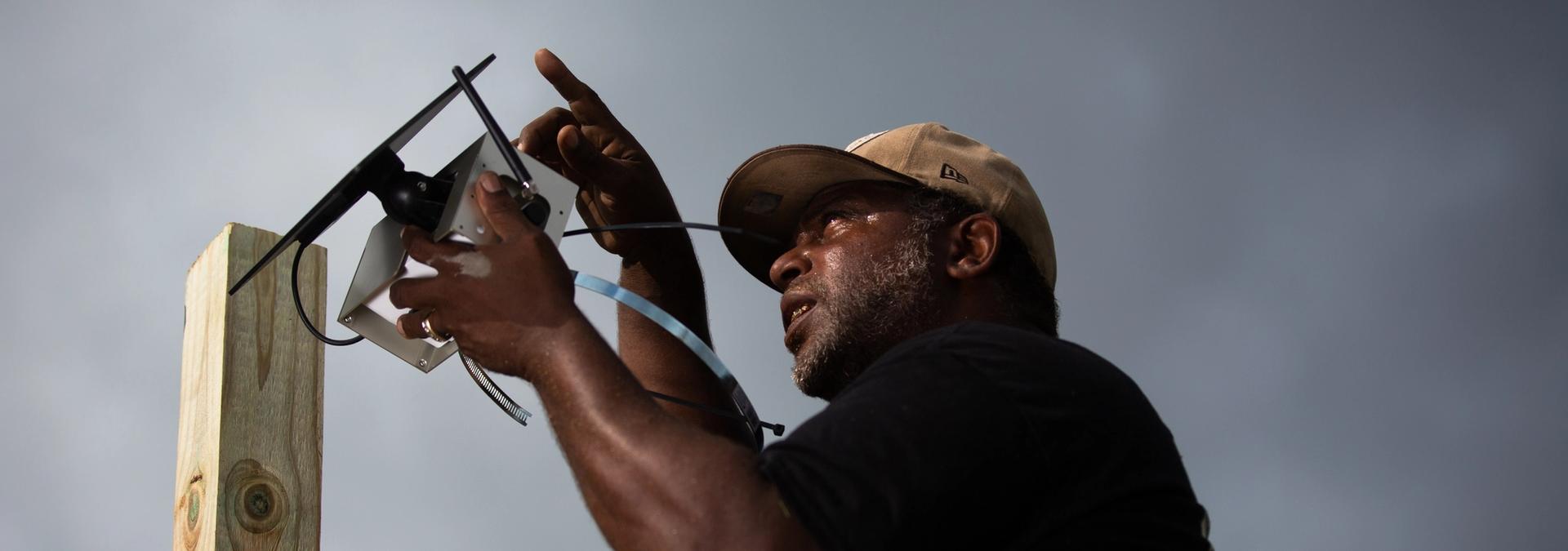
Communities can monitor their air. Only good government can improve it.
Five new monitors were installed in the fall of 2020 by Sunnyside residents to detect levels of harmful air pollution. Photo: Marie D. De Jesús.
Sunnyside, for Debra Walker, has always been about the fulfillment of a dream.
When she was a kid in the late 1960s, her mom moved the family there in pursuit of better schools and larger lawns to play in. Walker soon fell in love, proud to be a part of the first neighborhood in Houston developed for Black residents. “Every Halloween, I would walk down the street looking at houses and pick out which one would be mine one day,” Walker now says, laughing.
Sunnyside was developed in 1912, platted by a white former city council member on rural land in southwest Houston. The promises of real estate, though, came up against the realities of racism. Many Black Houstonians eager to own a plot of their own were also likely being charged exorbitant loan rates on everything from the land to the very timber they used for construction. Since Sunnyside lay outside city limits, officials also weren’t required to provide basic services like paved roads or sewers.
Instead, those who lived there provided for themselves, coming together to open schools, get running water, organize public safety departments and develop community centers. This has always been Sunnyside.
It took just a few decades for the city to annex it and start dumping on it — a landfill was sited on Holmes Road in the 1930s. Though most of Sunnyside’s streets remained compacted dirt, the city paved the one to the landfill, residents recall.
Despite their protests, another landfill opened nearby on Reed Road in 1964, with an incinerator added to the original, transmuting thousands of tons of other people’s car batteries, rubber tires and broken household appliances into choking smoke that combined dangerously with the lung-burning smog coming from traffic on the newly built Loop 610.
This was no accident, Dr. Robert Bullard, the Texas Southern University sociology professor, has written. All five of the city’s landfills that opened between the 1920s and ‘70s ended up in Black neighborhoods, along with six of the eight incinerators. (The other two incinerators were in Hispanic communities.) “Somebody was making these decisions,” Dr. Bullard said in an interview. “It was not random. Everybody produces garbage, but everybody doesn’t have to live next to a landfill.”
By the time Walker was an adult, it made sense to her to follow her neighbors out of Sunnyside altogether to the suburbs, fleeing the violence and economic downturn decimating her neighborhood after the 1980s oil bust. Still, she never forgot her dream. She missed the feeling of community, of belonging, she’d known. “I had faith in Sunnyside,” she says, “and I knew what it had been and what it could be.”
In Pleasantville, ‘we waited for years’
Like Sunnyside, Houston’s Pleasantville was advertised as a suburban paradise for Black homeowners, offering sleek-lined homes with knotty pine kitchen cabinets, attic fans to cool the houses and rambling lawns that created an almost rural quality for the first residents in the early 1950s. “It seemed too good to be true, when most planned neighborhoods were strictly segregated by deed restrictions,” Bridgette Murray says, “to have a community planned for Black Houstonians during that Jim Crow era.”
In 1957, the same year Murray’s parents bought their home, two ruptures in a 10-acre containment area of the nearby Houston Ship Channel sent roughly four feet of sludge into Pleasantville. The then-more-aptly-named Texas Highway Department decided to slice Interstate 10 across the top of Pleasantville just one year later. Loop 610, in 1974, sliced through the east side.
Six years later, Murray moved back to her childhood home after her father’s death from cancer. In 1995, she witnessed a chemical storage warehouse owned by Houston Distribution Inc. erupt in flames, chugging smoke and soot into the air while firefighters struggled for three weeks to control it. The air got so bad some residents had to evacuate.
Afterward, Murray says residents were encouraged not to eat any of their garden vegetables that season, in case the plants had been coated with toxic chemicals. “I’d never had asthma or lung problems in my life, but after that fire, I started coughing,” Murray recalls. “It became hard to breathe when I rode my bike through the neighborhood.”
More troubling, there was no significant government follow-up once the fire was finally put out. The closest Texas Commission on Environmental Quality (TCEQ) air monitor was stationed two miles away.
Despite complaints and reports of increased sinus problems, asthma, COPD and even lung cancer over the following years — the nationwide average is 30 cases per one million people, while Pleasantville’s rate is 50 cases per one million people, according to the Environmental Protection Agency (EPA) — no other monitors were subsequently installed nearby. “We waited for years for someone to come in and start looking at what was going on with our air,” Murray says. “But nobody came.”
Meetings with Pleasantville residents and a detailed analysis of the community revealed that air quality had been a widespread concern for years. Done waiting, they decided to start looking at what was going on with their air themselves.
The nonprofit Murray founded, Achieving Community Tasks Successfully (ACTS), won a grant to build their own network of seven air monitors, which they installed one morning in 2019. They’ve been gathering data ever since.
These lower-cost monitors are different from the so-called “regulatory-grade” ones that TCEQ and the EPA use to enforce industry compliance with environmental protections. The federal Clean Air Act, passed in the 1970s, requires them, in fact. But they must be housed in large trailers, require constant maintenance and are routinely taken down or knocked out during massive pollution events like hurricanes or winter storms. They’re precise, says Katie Moore, an environmental project manager with Clarity, the company that designed and manufactured the monitors used in Pleasantville, but their cost and size means there won’t ever be enough of them to catch everything emitted into the air.
This regulatory system, Moore says, doesn’t “account for hotspots and communities who might be experiencing more pollution than most. That’s where these monitors come in. A lot of communities like Pleasantville and Sunnyside already know a lot about what the problem is, but they don’t have the data.”
The smaller, solar-powered monitors installed in Pleasantville detect a range of airborne toxic substances, including particle pollution, a problem in a community bordered by busy freeways where heavy-duty, diesel-powered trucks come and go from a large industrial brewery. Sometimes written as PM 2.5, this pollution can lodge deep in the lungs and enter the bloodstream, leading to asthma, lung disease, heart attacks and premature death. It’s the most widespread pollutant in the U.S.
Knowing this, as Moore says, residents in other communities with a disproportionately high number of potential pollution sources — including Galena Park, Pasadena, Jacinto City, Kashmere Gardens, Near Northside and Gulfton — are working with Air Alliance Houston to install their own monitors, too, combining the increasing precision of the science with the power of their personal stories to compel officials to stop looking away. “We're collecting data to confirm our community concerns and request intervention," Murray says. "There are a lot of communities who want to be able to put together programs where they have some kind of confidence in the information they’re getting. That’s what we’ve wanted to demonstrate. As a community, you can do this, too.”
‘I could see it for myself’
Even though Walker had made a hard choice to leave Sunnyside to raise her children, she never felt the same about her new neighborhoods. In 2000, she and her husband returned, building a one-story house for them to grow old together in on a lot just down the street from where she’d grown up.
“It was coming home,” says Walker, who now directs the nonprofit Sunnyside Community Redevelopment Corporation (SCRO). “The dumps had been closed, the incinerator was gone. Sunnyside still had problems, but I knew we were more than that. I started working to make our community better, and I haven’t really stopped.”
As SCRO began meeting with Sunnyside residents and analyzing social data about their community, it “prompted a dialogue,” Walker says. “It became clear that implementing an air monitoring program would be the first step to improve the quality of life.”
SCRO secured grants and additional funding to develop an action plan and install their own network of the same solar-powered monitors that Pleasantville leaders had used. Three were installed near churches, one behind a barber shop, and another went up right in front of Walker’s own house. They are already gathering data all residents can freely access and use as an advocacy tool. This is what we’re breathing, they can show officials. What do you plan to do about it?
SCRO is now looking for funding to install even more monitors and build out their network. “These communities have lived with redlining, with industrial facilities and waste clustering in their communities for generations, with little being done by those in power to fix these situations,” says Dr. Grace Tee Lewis, a health scientist working with Walker and Murray for Environmental Defense Fund. “Ultimately, the goal is for more investigation, more enforcement, and more regulation-level monitors placed in more residential areas in environmental justice communities.”
This must come from city, state and federal government working together to ensure everyone’s health and safety. Though leaders like Walker and Murray can measure pollution in their communities, they can’t inspect facilities to determine the source of it. They can’t deny permits or issue fines for violations. That’s up to the one agency that can, TCEQ. As the agency goes through a review process led by the state Sunset Advisory Commission starting in 2022 to ensure its effectiveness, it would do well to become as strong as the communities it exists to protect.
The day technicians arrived to install the monitor at her house, Walker, though still recovering from Covid, was out in her yard, celebrating. “This is a historical milestone for SCRO and for the Sunnyside neighborhood,” she says. Every so often, she steps over to it, just to convince herself this is really happening. “The other day there was a fire, and I wondered what it was doing to the air,” she says. “So I went and looked at the data and there it was, a spike. I could see it for myself.”
Wray is a nationally award-winning journalist with bylines in The Atlantic, Huffington Post and The Guardian. She is based in Houston. You can find her on Twitter @diannawray or via email at wraydianna@gmail.com.
STAY UP TO DATE
The quality of our newsletter is considered satisfactory and poses little or no risk.
SUBSCRIBE

